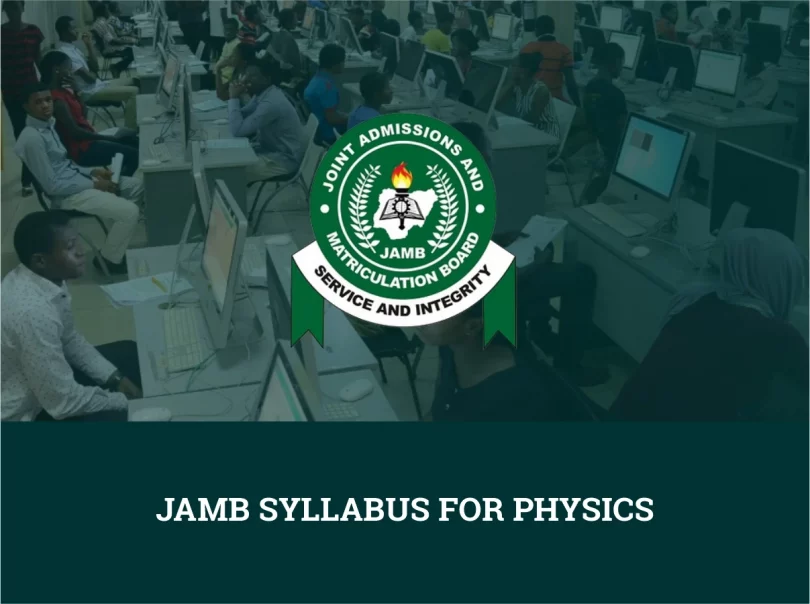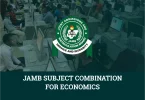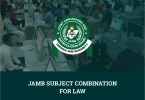JAMB Syllabus For Physics 2025 – Preparing for the JAMB Physics exam starts with knowing what to study. The Joint Admissions and Matriculation Board (JAMB) has outlined specific topics every candidate must cover to succeed in the UTME.
In this article, we have not only provided the complete JAMB Syllabus for Physics but also included a list of recommended textbooks to guide your revision and deepen your understanding. Read on to see the full syllabus and other important information.
JAMB Syllabus For Physics 2025
Below is a detailed physics syllabus for the 2025 JAMB. Candidates should make sure they learn everything about the topics listed in the syllabus so they can easily ace the examination.
1. Measurements and Units
- Length, area, and volume: Metre rule, Vernier calipers, Micrometer screw gauge, Measuring cylinder
- Mass: Unit of mass, Use and concept of simple beam balance
- Time: Unit of time, Time-measuring devices
- Fundamental physical quantities
- Derived physical quantities and their units: Combinations of fundamental quantities and determination of their units
- Dimensions: Definition and simple examples
- Limitations of experimental measurements: Accuracy of instruments, Estimation of errors, Significant figures, Standard form
- Measurement, position, distance, and displacement: Concept of displacement, Difference between distance and displacement, Concept of position and coordinates, Frame of reference
2. Scalars and Vectors
- Definition and examples of scalar and vector quantities
- Relative velocity
- Resolution of vectors into two perpendicular directions, including graphical methods
3. Motion
- Types of motion: Translational, Oscillatory, Rotational, Spin, Random
- Relative motion
- Causes of motion
- Types of force: Contact and force field
- Linear motion: Speed, velocity, acceleration; Equations of motion; Motion under gravity; Distance-time and velocity-time graphs; Instantaneous velocity and acceleration
- Projectiles: Range, height, time of flight; Applications
- Newton’s laws of motion: Inertia, mass, force; Mass-acceleration relationship; Impulse and momentum; Force-time graph; Conservation of linear momentum
- Circular motion: Angular velocity/acceleration, Centripetal and centrifugal forces, Applications
- Simple Harmonic Motion (SHM): Definition and examples; Period, frequency, amplitude; Velocity, acceleration; Energy changes; Forced vibration and resonance
4. Gravitational Field
- Newton’s law of universal gravitation
- Gravitational potential
- Conservative and non-conservative fields
- Acceleration due to gravity and the distinction between mass and weight
- Escape velocity
- Parking orbit and weightlessness
5. Equilibrium of Forces
- Equilibrium of particles: Coplanar forces, Triangles and polygon of forces, Lami’s theorem
- Principles of moments: Moment of force, Moment of a couple (torque), Applications
- Conditions for equilibrium of rigid bodies: Resolution and composition of forces, Resultant and equilibrant
- Centre of gravity and stability: Stable, unstable, and neutral equilibrium
6. Work, Energy, and Power
- Work, energy, power: Definitions and forms
- Conservation of energy; Energy transformation
- Area under the force-distance curve
- Energy and society: Sources (renewable & non-renewable), Uses, Diversification, Environmental impact (e.g., global warming, spillage), Energy crisis
- Devices for energy production
- Dams and energy: Locations, Production
- Nuclear energy
- Solar energy: Solar collectors, Solar panels
7. Friction
- Static and dynamic friction
- Coefficient of limiting friction and how to determine it
- Advantages and disadvantages of friction
- Reduction of friction
- Qualitative treatment of viscosity and terminal velocity
- Stoke’s law
8. Simple Machines
- Definition and types of simple machines
- Mechanical advantage, velocity ratio, and efficiency
9. Elasticity
- Elastic limit, yield point, breaking point
- Hooke’s law and Young’s modulus
- The spring balance as a force-measuring device
- Work done per unit volume in springs and elastic strings
10. Pressure
Atmospheric Pressure:
- Definition, Units (Pascal), Measurement
- Mercury barometer, Aneroid barometer, Manometer
- Variation with height
- Barometer as an altimeter
Pressure in Liquids:
- Pressure-depth-density relationship (P = ρgh)
- Pascal’s Principle and applications
11. Liquids at Rest
- Determination of the density of solids and liquids
- Relative density
- Upthrust and Archimedes’ principle
- Law of flotation and applications (e.g., ships, hydrometers)
12. Temperature and Its Measurement
- Concept of temperature
- Thermometric properties
- Calibration of thermometers
- Celsius and Kelvin scales
- Types of thermometers
- Temperature scale conversions
13. Thermal Expansion
Solids:
- Linear, area, and volume expansivities; Determination
- Applications (e.g, building gaps, rail lines)
- Relationships among expansivities
Liquids:
- Volume expansivity: Real and apparent expansion
- Determination
- Anomalous expansion of water
14. Gas Laws
- Boyle’s law (Isothermal)
- Charles’ law (Isobaric)
- Pressure law (Volumetric)
- Absolute zero of temperature
- General gas equation (PV/T = constant)
- Ideal gas equation (PV = nRT)
- Van der Waals gas
15. Quantity of Heat
- Heat as energy
- Heat capacity and specific heat capacity (solids & liquids)
- Determination methods: Mixtures, Electrical, Newton’s cooling
16. Change of State
- Latent heat; Specific latent heat of fusion and vaporization
- Melting, evaporation, and boiling
- Influence of pressure and impurities on boiling/melting points
- Applications in devices
17. Vapours
- Saturated and unsaturated vapours
- Saturated vapour pressure and boiling
- Determination of S.V.P using barometer tube
- Dew, mist, fog, and rain formation
- Dew point, humidity, and relative humidity
- Hygrometry using wet and dry bulb thermometers
18. Structure of Matter and Kinetic Theory
- Molecular Nature:
- Atoms and molecules
- Explanation of Brownian motion, diffusion, surface tension, capillarity, adhesion, cohesion
- Kinetic Theory:
- Assumptions
- Applications of gas laws, boiling, melting, and evaporation
19. Heat Transfer
- Modes of heat transfer: Conduction, Convection, Radiation
- Temperature gradient, Thermal conductivity, Heat flux
- Surface properties and radiation/absorption
- Conductivities of materials
- Thermos flask
- Land and sea breeze
- Engines
20. Waves
Production & Propagation:
- Wave motion, Vibrating sources
- Waves as an energy transfer
- Particle vs wave motion
- Frequency, wavelength, wave speed (v = fλ)
- Phase difference, Wave number/vector
- Progressive wave equation
Classification:
- Mechanical vs electromagnetic waves
- Longitudinal vs transverse
- Stationary vs progressive
- Examples: Springs, ropes, ripple tank
Characteristics/Properties:
- Reflection, refraction, diffraction, polarization
- Superposition, interference
- Beats
- Doppler effect (qualitative)
21. Propagation of Sound Waves
- Need for a material medium
- Speed in solids, liquids, and air
- Reflection, echoes, reverberation, and applications
- Problems caused by echoes and reverberations
22. Characteristics of Sound Waves
- (i) noise and musical notes
(ii) quality, pitch, intensity, and loudness, and their application to musical instruments;
(iii) simple treatment of overtones produced by vibrating strings and their columns F0=12LTμ−−√F0=12LTμ; (μ=mlμ=ml)
(iv) Acoustic examples of resonance
(v) frequency of a note emitted by air columns in closed and open pipes about their lengths.
23. Light Energy
- (a) Sources of Light:
(i) natural and artificial sources of light
(ii) luminous and non-luminous objects - (b) Propagation of light
(i) speed, frequency, and wavelength of light
(ii) formation of shadows and eclipse
(iii) the pin-hole camera.
24. Reflection of Light at Plane and Curved Surfaces
- (i) Laws of reflection
- (ii) Applications of reflection of light
- (iii) Formation of images by plane, concave, and convex mirrors with ray diagrams
- (iv) Use of the mirror formula: 1f=1u+1v\frac{1}{f} = \frac{1}{u} + \frac{1}{v}f1=u1+v1
- (v) Linear magnification
25. Refraction of Light at Plane and Curved Surfaces
- (i) Explanation of refraction in terms of the velocity of light in different media
- (ii) Laws of refraction
- (iii) Definition of refractive index of a medium
- (iv) Determination of refractive index of glass and liquids using Snell’s Law
- (v) Real and apparent depth; lateral displacement
- (vi) Critical angle and total internal reflection
(b) Glass Prism and Lenses
- (i) Use of the minimum deviation formula:
μ=sin(A+D2)sin(A2)\mu = \frac{\sin\left(\frac{A + D}{2}\right)}{\sin\left(\frac{A}{2}\right)}μ=sin(2A)sin(2A+D) - (ii) Types of lenses
- (iii) Use of lens formula: 1f=1u+1v\frac{1}{f} = \frac{1}{u} + \frac{1}{v}f1=u1+v1 and Newton’s formula F2=abF^2 = abF2=ab
- (iv) Magnification
26. Optical Instruments
- (i) Principles of microscopes, telescopes, projectors, cameras, and the human eye (excluding physiological details)
- (ii) Power of a lens
- (iii) Angular magnification
- (iv) Near and far points
- (v) Sight defects and their corrections
27. (a) Dispersion of Light and Colours
- (i) Dispersion of white light by a triangular prism
- (ii) Production of a pure spectrum
- (iii) Colour mixing by addition and subtraction
- (iv) Colour of objects and colour filters
- (v) Rainbow formation
(b) Electromagnetic Spectrum
- (i) Description of sources and uses of various types of radiation
28. Electrostatics
- (i) Existence of positive and negative charges in matter
- (ii) Charging a body by friction, contact, and induction
- (iii) The electroscope
- (iv) Coulomb’s inverse square law, electric field, and potential
- (v) Electric field intensity and potential difference
- (vi) Electric discharge and lightning
29. Capacitors
- (i) Types and functions of capacitors
- (ii) Parallel plate capacitors
- (iii) Capacitance of a capacitor
- (iv) Relation: C=εAdC = \frac{\varepsilon A}{d}C=dεA
- (v) Capacitors in series and parallel
- (vi) Energy stored in a capacitor
30. Electric Cells
- (i) Simple voltaic cell and its defects
- (ii) Daniel cell, Leclanché cell (wet and dry)
- (iii) Lead-acid accumulator, Nickel-Iron (NiFe), Lithium-ion, and Mercury-cadmium cells
- (iv) Maintenance of cells and batteries (without chemical detail)
- (v) Arrangement of cells
- (vi) Efficiency of a cell
31. Current Electricity
- (i) Electromotive force (e.m.f.), potential difference, current, internal resistance, and lost volts
- (ii) Ohm’s Law
- (iii) Measurement of resistance
- (iv) Meter bridge
- (v) Series and parallel resistance combinations
- (vi) Potentiometer for measuring e.m.f., current, and internal resistance
- (vii) Electrical networks
32. Electrical Energy and Power
- (i) Concepts of electrical energy and power
- (ii) Commercial units of electricity
- (iii) Electric power transmission
- (iv) Heating effect of current
- (v) Electrical wiring in houses
- (vi) Use of fuses
33. Magnets and Magnetic Fields
- (i) Natural and artificial magnets
- (ii) Magnetic properties of soft iron and steel
- (iii) Magnetization and demagnetization methods
- (iv) Concept of magnetic fields
- (v) Magnetic field of permanent magnets
- (vi) Fields around current-carrying conductors, circular wires, and solenoids
- (vii) Earth’s magnetic field (poles, meridian, dip, declination)
- (viii) Magnetic flux and flux density
- (ix) Variation of magnetic field intensity across Earth’s surface
- (x) Applications in navigation and mineral exploration
34. Force on a Current-Carrying Conductor in a Magnetic Field
- (i) Force between parallel current-carrying conductors
- (ii) Force on a moving charge in a magnetic field
- (iii) Direct current (d.c.) motor
- (iv) Electromagnets
- (v) Carbon microphone
- (vi) Moving-coil and moving-iron instruments
- (vii) Converting galvanometers to ammeters/voltmeters using shunts and multipliers
- (viii) Galvanometer sensitivity
35. (a) Electromagnetic Induction
- (i) Faraday’s laws
- (ii) Factors affecting induced e.m.f.
- (iii) Lenz’s Law and energy conservation
- (iv) A.C. and D.C. generators
- (v) Transformers
- (vi) Induction coil
(b) Inductance
- (i) Meaning and unit of inductance
- (ii) Energy stored: E=12LI2E = \frac{1}{2} LI^2E=21LI2
- (iii) Uses of inductors
(c) Eddy Currents
- (i) Reduction of eddy currents
- (ii) Applications of eddy currents
36. Simple A.C. Circuits
- (i) Concept of alternating current and voltage
- (ii) Peak and RMS values
- (iii) A.C. with resistors
- (iv) A.C. with capacitors (capacitive reactance)
- (v) A.C. with inductors (inductive reactance)
- (vi) Series R-L-C circuits
- (vii) Vector diagrams, phase angle, power factor
- (viii) Resistance and impedance
- (ix) Effective voltage in R-L-C circuits
- (x) Resonance and formula: f0=12πLCf_0 = \frac{1}{2\pi\sqrt{LC}}f0=2πLC1
37. Conduction of Electricity Through:
(a) Liquids
- (i) Electrolytes and non-electrolytes
- (ii) Electrolysis
- (iii) Faraday’s laws of electrolysis
- (iv) Applications: electroplating, ammeter calibration, etc.
(b) Gases
- (i) Discharge through gases (qualitative)
- (ii) Applications of gas conduction
38. Elementary Modern Physics
- (i) Atomic models and limitations
- (ii) Atomic structure
- (iii) Energy levels and spectra
- (iv) Thermionic and photoelectric emissions
- (v) Einstein’s equation and stopping potential
- (vi) Applications of thermionic and photoelectric effects
- (vii) X-ray production
- (viii) Alpha, beta, gamma radiation (properties & applications)
- (ix) Half-life and decay constant
- (x) Energy from nuclear fusion and fission
- (xi) Mass defect, binding energy, and ΔE=Δmc2\Delta E = \Delta mc^2ΔE=Δmc2
- (xii) Wave-particle duality
- (xiii) Electron diffraction
- (xiv) Uncertainty principle
39. Introductory Electronics
- (i) Difference between metals, semiconductors, and insulators (including basic band gap)
- (ii) Intrinsic and extrinsic semiconductors
- (iii) Applications: diodes in rectification; transistors in amplification
- (iv) n-type and p-type semiconductors
- (v) Basic knowledge of diodes and transistors
Recommended Texts For JAMB Physics 2025
These are the texts you should make use of for your studies. Also, make use of the JAMB past questions for physics so you can learn how to answer questions and manage your time.
- Ike E.E. (2014) Essential Principles of Physics, Jos ENIC publishers
- IkeE.E.E (2014) Numerical Problems and Solutions in Physics, Jos ENIC publishers
- Nelson M. (1977) Fundamentals of Physics, Great Britain, Hart Davis Education
- Nelson M. and Parker … (1989) Advanced Level Physics, (Sixth Edition) Heinemann
- Okeke, P.N., and Anyakoha, M.W. (2000). Senior Secondary School Physics, Lagos, Pacific Printers
- Olumuyiwa A. and Ogunkoya O. O (1992) Comprehensive Certificate Physics, Ibadan: University Press Plc.
Have any questions about the JAMB Syllabus for Physics? Feel free to use the comment section below.







Leave a Comment